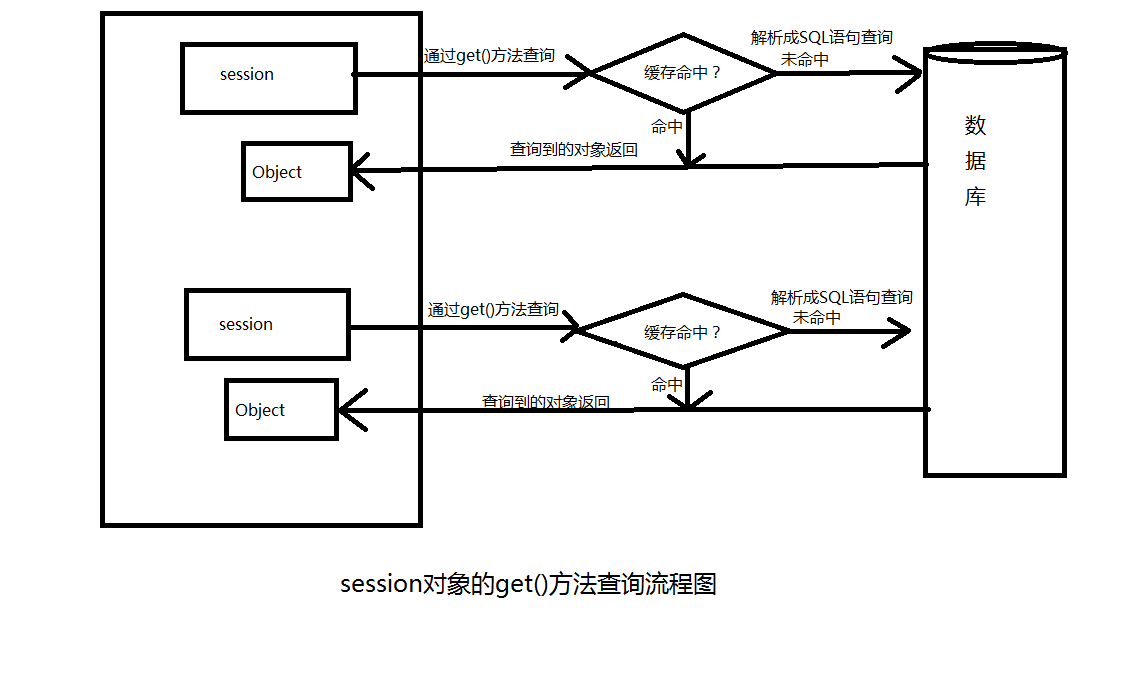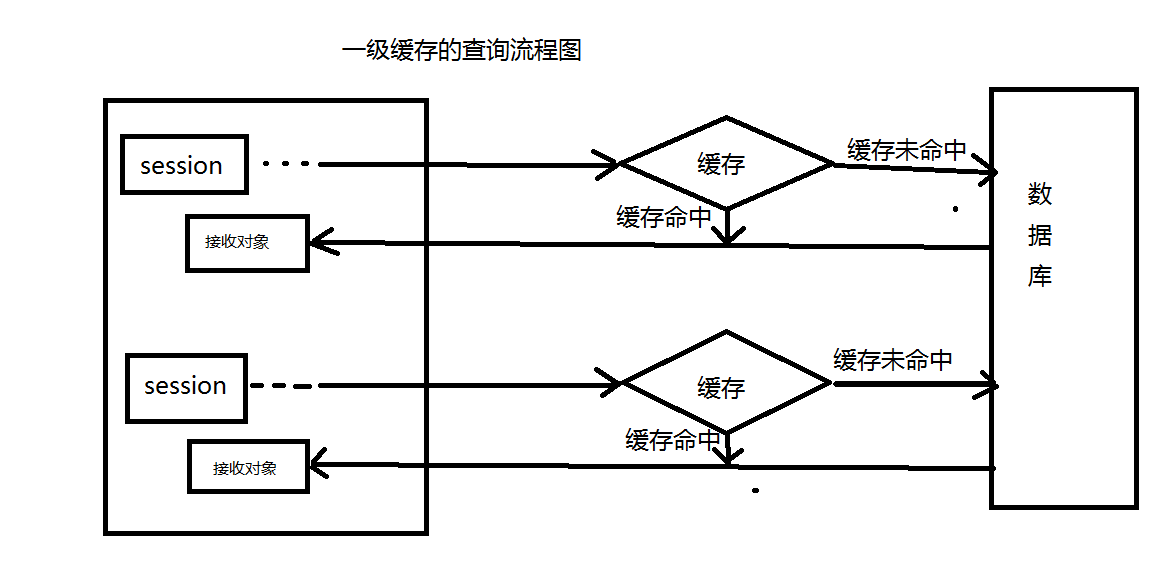Hibernate一级缓存(基于查询分析)
首先我们应该弄清什么是hibernate缓存:hibernate缓存是指为了降低应用程序对物理数据源的访问频次,从而提高应用程序的运行性能的一种策略。我们要将这个跟计算机内存或者cpu的缓存区分开。
一、hibernate查询的几种方式
既然是基于查询分析hibernate一级缓存,我们就来分析分析hibernate查询方式
1、通过session对象的get()方法
我们通过查看hibernate的api文档找到了session接口,并重点看了get()方法,我们主要使用一下两种get()方法:
通过传入由实体类获得的Class类对象(姑且叫做类类型)和该类的唯一标识符两个参数,返回一个Object类型的查询对象。

通过传入实体类名和该类对象的唯一标识符两个参数,返回一个Object类型的查询对象。
代码示例:
package com.third; import java.util.List; import org.hibernate.Query;
import org.hibernate.Session;
import org.hibernate.SessionFactory;
import org.hibernate.Transaction;
import org.hibernate.cfg.Configuration;
import org.hibernate.service.ServiceRegistry;
import org.hibernate.service.ServiceRegistryBuilder;
import org.junit.After;
import org.junit.Before;
import org.junit.Test; import com.third.Dao2.Students2;
import com.third.Dao2.Students2PartInfo; public class Test3 {
private static SessionFactory sessionFactory;
private static Session session;
private static Transaction transaction;
@Before
public void init(){
//先获取配置对象,匹配hibernate.cfg.xml文件
Configuration config=new Configuration().configure();
//获取注册服务对象(该对象中包含hibernate.cfg.xml中的<properties>和<maping>信息
ServiceRegistry serviceRegistry=new ServiceRegistryBuilder().applySettings(config.getProperties()).buildServiceRegistry();
//获取sessionFactory对象,通过sessionFactory对象读取hibernate.cfg.xml文档信息,并通过<mapping>标签加载hbm.xml文件信息
sessionFactory=config.buildSessionFactory(serviceRegistry);
} @Test
public void test3(){
//通过sessionFactory对象获取session对象
session=sessionFactory.openSession();
//通过session对象开启事务,并且返回事务(transaction)对象
transaction=session.beginTransaction(); //第一个session对象通过get()方法第一次查询相同记录
Students2 stu1=(Students2) session.get(Students2.class, 1);
//第一个session对象通过get()函数第二次查询相同记录
Students2 stu2=(Students2) session.get(Students2.class, 1);
System.out.println("学号:"+stu1.getSid()
+" 姓别:"+stu1.getSgender()+" 姓名:"+stu1.getSname());
System.out.println("学号:"+stu2.getSid()
+" 姓别:"+stu2.getSgender()+" 姓名:"+stu2.getSname()); //重新获得一个session对象,再一次执行session对象的get()方法查询相同记录
Session session1=sessionFactory.openSession();
Students2 stu3=(Students2) session1.get(Students2.class, 1);
System.out.println("学号:"+stu3.getSid()
+" 姓别:"+stu3.getSgender()+" 姓名:"+stu3.getSname()); } @After
public void destory(){
transaction.commit();
//关闭开启的资源
if(session!=null){
session.close();
}
if(sessionFactory!=null){
sessionFactory.close();
}
}
}
运行结果:
Hibernate:
select
students2x0_.SID as SID1_1_0_,
students2x0_.SNAME as SNAME2_1_0_,
students2x0_.SGENDER as SGENDER3_1_0_
from
STUDENTS2 students2x0_
where
students2x0_.SID=?
学号:1 姓别:女 姓名:小美
学号:1 姓别:女 姓名:小美
Hibernate:
select
students2x0_.SID as SID1_1_0_,
students2x0_.SNAME as SNAME2_1_0_,
students2x0_.SGENDER as SGENDER3_1_0_
from
STUDENTS2 students2x0_
where
students2x0_.SID=?
学号:1 姓别:女 姓名:小美
分析:在同一个session对象的条件下查询同一表格记录,hibernate解析的SQL语句只会执行一次,重新获得一个session对象后,再去查询相同的表格记录时,hibernate解析而成的SQL语句会在执行一次。
我们不难得出:在同一个session对象的情况下,使用get()方法查询相同的对象会使用到缓存(一级缓存),不同的session对象在查询相同对象正常情况下是不会使用缓存。

2、通过session的load()方法
我们通过查看hibernate的api文档找到了session接口,并重点看了load()方法,我们主要使用一下两种load()方法:

通过传入由实体类获得的Class类对象(姑且叫做类类型)和该类的唯一标识符两个参数,返回一个Object类型的查询对象。

通过传入实体类名和该类对象的唯一标识符两个参数,返回一个Object类型的查询对象。
代码示例:
package com.third; import java.util.List; import org.hibernate.Query;
import org.hibernate.Session;
import org.hibernate.SessionFactory;
import org.hibernate.Transaction;
import org.hibernate.cfg.Configuration;
import org.hibernate.service.ServiceRegistry;
import org.hibernate.service.ServiceRegistryBuilder;
import org.junit.After;
import org.junit.Before;
import org.junit.Test; import com.third.Dao2.Students2;
import com.third.Dao2.Students2PartInfo; public class Test3 {
private static SessionFactory sessionFactory;
private static Session session;
private static Transaction transaction;
@Before
public void init(){
//先获取配置对象,匹配hibernate.cfg.xml文件
Configuration config=new Configuration().configure();
//获取注册服务对象(该对象中包含hibernate.cfg.xml中的<properties>和<maping>信息
ServiceRegistry serviceRegistry=new ServiceRegistryBuilder().applySettings(config.getProperties()).buildServiceRegistry();
//获取sessionFactory对象,通过sessionFactory对象读取hibernate.cfg.xml文档信息,并通过<mapping>标签加载hbm.xml文件信息
sessionFactory=config.buildSessionFactory(serviceRegistry);
} @Test
public void test3(){
//通过sessionFactory对象获取session对象
session=sessionFactory.openSession();
//通过session对象开启事务,并且返回事务(transaction)对象
transaction=session.beginTransaction(); //第一个session对象通过get()方法第一次查询相同记录
Students2 stu1=(Students2) session.load(Students2.class, 1);
//第一个session对象通过get()函数第二次查询相同记录
Students2 stu2=(Students2) session.load(Students2.class, 1);
System.out.println("学号:"+stu1.getSid()
+" 姓别:"+stu1.getSgender()+" 姓名:"+stu1.getSname());
System.out.println("学号:"+stu2.getSid()
+" 姓别:"+stu2.getSgender()+" 姓名:"+stu2.getSname()); //重新获得一个session对象,再一次执行session对象的get()方法查询相同记录
Session session1=sessionFactory.openSession();
Students2 stu3=(Students2) session1.load(Students2.class, 1);
System.out.println("学号:"+stu3.getSid()
+" 姓别:"+stu3.getSgender()+" 姓名:"+stu3.getSname()); } @After
public void destory(){
transaction.commit();
//关闭开启的资源
if(session!=null){
session.close();
}
if(sessionFactory!=null){
sessionFactory.close();
}
}
}
运行结果:
Hibernate:
select
students2x0_.SID as SID1_1_0_,
students2x0_.SNAME as SNAME2_1_0_,
students2x0_.SGENDER as SGENDER3_1_0_
from
STUDENTS2 students2x0_
where
students2x0_.SID=?
学号:1 姓别:女 姓名:小美
学号:1 姓别:女 姓名:小美
Hibernate:
select
students2x0_.SID as SID1_1_0_,
students2x0_.SNAME as SNAME2_1_0_,
students2x0_.SGENDER as SGENDER3_1_0_
from
STUDENTS2 students2x0_
where
students2x0_.SID=?
学号:1 姓别:女 姓名:小美
分析:在同一个session对象的条件下查询同一表格记录,hibernate解析的SQL语句只会执行一次,重新获得一个session对象后,再去查询相同的表格记录时,hibernate解析而成的SQL语句会在执行一次。
我们不难得出:在同一个session对象的情况下,使用load()方法查询相同的对象会使用到缓存(一级缓存),不同的session对象在查询相同对象正常情况下是不会使用缓存。
我们可以总结得到,load()函数的查询流程和get()函数的查询流程基本相同。
3、通过session对象的createQuery(String HQL)方法
我们通过查看hibernate的api文档找到了session接口,找到createQuery(String HQL)方法,该方法的返回值类型是一个Query(查询),于是,我们找到Query接口,我们找到了两个方法,是将查询结果返回的。

以List的方式返回查询结果

以迭代器的方式返回查询结果
(1)以List的方式返回查询结果
1)有select子句
package com.third; import java.util.List; import org.hibernate.Query;
import org.hibernate.Session;
import org.hibernate.SessionFactory;
import org.hibernate.Transaction;
import org.hibernate.cfg.Configuration;
import org.hibernate.service.ServiceRegistry;
import org.hibernate.service.ServiceRegistryBuilder;
import org.junit.After;
import org.junit.Before;
import org.junit.Test; import com.third.Dao2.Students2;
import com.third.Dao2.Students2PartInfo; public class Test3 {
private static SessionFactory sessionFactory;
private static Session session;
private static Transaction transaction;
@Before
public void init(){
//先获取配置对象,匹配hibernate.cfg.xml文件
Configuration config=new Configuration().configure();
//获取注册服务对象(该对象中包含hibernate.cfg.xml中的<properties>和<maping>信息
ServiceRegistry serviceRegistry=new ServiceRegistryBuilder().applySettings(config.getProperties()).buildServiceRegistry();
//获取sessionFactory对象,通过sessionFactory对象读取hibernate.cfg.xml文档信息,并通过<mapping>标签加载hbm.xml文件信息
sessionFactory=config.buildSessionFactory(serviceRegistry);
} @Test
public void test3(){
//通过sessionFactory对象获取session对象
session=sessionFactory.openSession();
//通过session对象开启事务,并且返回事务(transaction)对象
transaction=session.beginTransaction(); //创建HQL语句用于后面的查询需要
//查询所有记录的sid和sname信息(hql语句)
String hql=" select sid,sname,sgender from Students2"; //创建多条记录查询对象query1
Query query=session.createQuery(hql); /*
* 相同session对象,相同query对象,查询相同的对象
*/
List<Object[]> list=query.list();
for (Object[] objects : list) {
System.out.println("学号:"+objects[0]+" 姓名:"+objects[1]+" 性别:"+objects[2]);
} List<Object[]> list1=query.list();
for (Object[] objects : list1) {
System.out.println("学号:"+objects[0]+" 姓名:"+objects[1]+" 性别:"+objects[2]);
}
} @After
public void destory(){
transaction.commit();
//关闭开启的资源
if(session!=null){
session.close();
}
if(sessionFactory!=null){
sessionFactory.close();
}
}
}
运行结果:
Hibernate:
select
students2x0_.SID as col_0_0_,
students2x0_.SNAME as col_1_0_,
students2x0_.SGENDER as col_2_0_
from
STUDENTS2 students2x0_
学号:1 姓名:小美 性别:女
学号:2 姓名:小泽 性别:男
学号:3 姓名:小敏 性别:女
Hibernate:
select
students2x0_.SID as col_0_0_,
students2x0_.SNAME as col_1_0_,
students2x0_.SGENDER as col_2_0_
from
STUDENTS2 students2x0_
学号:1 姓名:小美 性别:女
学号:2 姓名:小泽 性别:男
学号:3 姓名:小敏 性别:女
2)没有select子句
package com.third; import java.awt.event.FocusEvent;
import java.util.Iterator;
import java.util.List; import org.hibernate.Query;
import org.hibernate.Session;
import org.hibernate.SessionFactory;
import org.hibernate.Transaction;
import org.hibernate.cfg.Configuration;
import org.hibernate.service.ServiceRegistry;
import org.hibernate.service.ServiceRegistryBuilder;
import org.junit.After;
import org.junit.Before;
import org.junit.Test; import com.third.Dao2.Students2;
import com.third.Dao2.Students2PartInfo; public class Test3 {
private static SessionFactory sessionFactory;
private static Session session;
private static Transaction transaction;
@Before
public void init(){
//先获取配置对象,匹配hibernate.cfg.xml文件
Configuration config=new Configuration().configure();
//获取注册服务对象(该对象中包含hibernate.cfg.xml中的<properties>和<maping>信息
ServiceRegistry serviceRegistry=new ServiceRegistryBuilder().applySettings(config.getProperties()).buildServiceRegistry();
//获取sessionFactory对象,通过sessionFactory对象读取hibernate.cfg.xml文档信息,并通过<mapping>标签加载hbm.xml文件信息
sessionFactory=config.buildSessionFactory(serviceRegistry);
} @Test
public void test3(){
//通过sessionFactory对象获取session对象
session=sessionFactory.openSession();
//通过session对象开启事务,并且返回事务(transaction)对象
transaction=session.beginTransaction(); String hql="from Students2";
Query query=session.createQuery(hql);
List<Students2> stu=query.list();
for (Students2 stu1 : stu) {
System.out.println("学号:"+stu1.getSid()+" 姓名:"+stu1.getSname()+" 性别:"+stu1.getSgender());
}
List<Students2> stu2=query.list();
for (Students2 stu3 : stu2) {
System.out.println("学号:"+stu3.getSid()+" 姓名:"+stu3.getSname()+" 性别:"+stu3.getSgender());
} } @After
public void destory(){
transaction.commit();
//关闭开启的资源
if(session!=null){
session.close();
}
if(sessionFactory!=null){
sessionFactory.close();
}
}
}
运行结果:
Hibernate:
select
students2x0_.SID as SID1_1_,
students2x0_.SNAME as SNAME2_1_,
students2x0_.SGENDER as SGENDER3_1_
from
STUDENTS2 students2x0_
学号:1 姓名:小美 性别:女
学号:2 姓名:小泽 性别:男
学号:3 姓名:小敏 性别:女
Hibernate:
select
students2x0_.SID as SID1_1_,
students2x0_.SNAME as SNAME2_1_,
students2x0_.SGENDER as SGENDER3_1_
from
STUDENTS2 students2x0_
学号:1 姓名:小美 性别:女
学号:2 姓名:小泽 性别:男
学号:3 姓名:小敏 性别:女
分析:相同session,甚至相同query对象情况下,查询相同的对象,hibernate解析的SQL语句在数据库执行了两次。
很明显能看出:session.createQuery(hql).list()方法,不会使用缓存。

(2)以迭代的方式返回查询结果
代码示例:
package com.third; import java.util.Iterator;
import java.util.List; import org.hibernate.Query;
import org.hibernate.Session;
import org.hibernate.SessionFactory;
import org.hibernate.Transaction;
import org.hibernate.cfg.Configuration;
import org.hibernate.service.ServiceRegistry;
import org.hibernate.service.ServiceRegistryBuilder;
import org.junit.After;
import org.junit.Before;
import org.junit.Test; import com.third.Dao2.Students2;
import com.third.Dao2.Students2PartInfo; public class Test3 {
private static SessionFactory sessionFactory;
private static Session session;
private static Transaction transaction;
@Before
public void init(){
//先获取配置对象,匹配hibernate.cfg.xml文件
Configuration config=new Configuration().configure();
//获取注册服务对象(该对象中包含hibernate.cfg.xml中的<properties>和<maping>信息
ServiceRegistry serviceRegistry=new ServiceRegistryBuilder().applySettings(config.getProperties()).buildServiceRegistry();
//获取sessionFactory对象,通过sessionFactory对象读取hibernate.cfg.xml文档信息,并通过<mapping>标签加载hbm.xml文件信息
sessionFactory=config.buildSessionFactory(serviceRegistry);
} @Test
public void test3(){
//通过sessionFactory对象获取session对象
session=sessionFactory.openSession();
//通过session对象开启事务,并且返回事务(transaction)对象
transaction=session.beginTransaction(); /*
* 这里我们执行带有select子句的查询
*/
//创建HQL语句用于后面的查询需要
//查询所有记录的sid和sname信息(hql语句)
String hql=" select sid,sname,sgender from Students2"; //创建多条记录查询对象query1
Query query=session.createQuery(hql);
System.out.println("*************带有select子句的查询*********************");
Iterator it=query.iterate();
while(it.hasNext()){
Object[] obj=(Object[])it.next();
System.out.println("学号:"+obj[0]+" 姓名:"+obj[1]+" 性别:"+obj[2]);
}
//在同一session同一query1对象下查询相同的对象
System.out.println("同一个session并且同一个query对象下查询相同对象:");
Iterator it2=query.iterate();
while(it2.hasNext()){
Object[] obj=(Object[])it2.next();
System.out.println("学号:"+obj[0]+" 姓名:"+obj[1]+" 性别:"+obj[2]);
}
System.out.println("**************不带select子句的查询**********************");
/*
* 这里我们执行不带有select子句的查询
*/
Session session1=sessionFactory.openSession();
String hql1="from Students2";
Query query1=session.createQuery(hql1);
Iterator<Students2> it1=query1.iterate();
while(it1.hasNext()){
Students2 stu=it1.next();
System.out.println("学号:"+stu.getSid()
+" 姓别:"+stu.getSgender()+" 姓名:"+stu.getSname());
}
//在同一session同一query1对象下查询相同的对象
System.out.println("在同一session同一query1对象下查询相同的对象:");
Iterator<Students2> it3=query1.iterate();
while(it3.hasNext()){
Students2 stu=it3.next();
System.out.println("学号:"+stu.getSid()
+" 姓别:"+stu.getSgender()+" 姓名:"+stu.getSname());
}
//在同一个session但是不是一个query对象下查询相同对象
System.out.println("在同一个session但是不是一个query对象下查询相同对象:");
Query query2=session.createQuery(hql1);
Iterator<Students2> it4=query2.iterate();
while(it4.hasNext()){
Students2 stu=it4.next();
System.out.println("学号:"+stu.getSid()
+" 姓别:"+stu.getSgender()+" 姓名:"+stu.getSname());
}
//在不同的session中,查询相同的对象
System.out.println("在不同的session中,查询相同的对象:");
Session session2=sessionFactory.openSession();
String hql2="from Students2";
Query query3=session2.createQuery(hql1);
Iterator<Students2> it5=query3.iterate();
while(it5.hasNext()){
Students2 stu=it5.next();
System.out.println("学号:"+stu.getSid()
+" 姓别:"+stu.getSgender()+" 姓名:"+stu.getSname());
}
} @After
public void destory(){
transaction.commit();
//关闭开启的资源
if(session!=null){
session.close();
}
if(sessionFactory!=null){
sessionFactory.close();
}
}
}
运行结果:
*************带有select子句的查询*********************
Hibernate:
select
students2x0_.SID as col_0_0_,
students2x0_.SNAME as col_1_0_,
students2x0_.SGENDER as col_2_0_
from
STUDENTS2 students2x0_
学号:1 姓名:小美 性别:女
学号:2 姓名:小泽 性别:男
学号:3 姓名:小敏 性别:女
同一个session并且同一个query对象下查询相同对象:
Hibernate:
select
students2x0_.SID as col_0_0_,
students2x0_.SNAME as col_1_0_,
students2x0_.SGENDER as col_2_0_
from
STUDENTS2 students2x0_
学号:1 姓名:小美 性别:女
学号:2 姓名:小泽 性别:男
学号:3 姓名:小敏 性别:女
**************不带select子句的查询**********************
Hibernate:
select
students2x0_.SID as col_0_0_
from
STUDENTS2 students2x0_
Hibernate:
select
students2x0_.SID as SID1_1_0_,
students2x0_.SNAME as SNAME2_1_0_,
students2x0_.SGENDER as SGENDER3_1_0_
from
STUDENTS2 students2x0_
where
students2x0_.SID=?
学号:1 姓别:女 姓名:小美
Hibernate:
select
students2x0_.SID as SID1_1_0_,
students2x0_.SNAME as SNAME2_1_0_,
students2x0_.SGENDER as SGENDER3_1_0_
from
STUDENTS2 students2x0_
where
students2x0_.SID=?
学号:2 姓别:男 姓名:小泽
Hibernate:
select
students2x0_.SID as SID1_1_0_,
students2x0_.SNAME as SNAME2_1_0_,
students2x0_.SGENDER as SGENDER3_1_0_
from
STUDENTS2 students2x0_
where
students2x0_.SID=?
学号:3 姓别:女 姓名:小敏
在同一session同一query1对象下查询相同的对象:
Hibernate:
select
students2x0_.SID as col_0_0_
from
STUDENTS2 students2x0_
学号:1 姓别:女 姓名:小美
学号:2 姓别:男 姓名:小泽
学号:3 姓别:女 姓名:小敏
在同一个session但是不是一个query对象下查询相同对象:
Hibernate:
select
students2x0_.SID as col_0_0_
from
STUDENTS2 students2x0_
学号:1 姓别:女 姓名:小美
学号:2 姓别:男 姓名:小泽
学号:3 姓别:女 姓名:小敏
在不同的session中,查询相同的对象:
Hibernate:
select
students2x0_.SID as col_0_0_
from
STUDENTS2 students2x0_
Hibernate:
select
students2x0_.SID as SID1_1_0_,
students2x0_.SNAME as SNAME2_1_0_,
students2x0_.SGENDER as SGENDER3_1_0_
from
STUDENTS2 students2x0_
where
students2x0_.SID=?
学号:1 姓别:女 姓名:小美
Hibernate:
select
students2x0_.SID as SID1_1_0_,
students2x0_.SNAME as SNAME2_1_0_,
students2x0_.SGENDER as SGENDER3_1_0_
from
STUDENTS2 students2x0_
where
students2x0_.SID=?
学号:2 姓别:男 姓名:小泽
Hibernate:
select
students2x0_.SID as SID1_1_0_,
students2x0_.SNAME as SNAME2_1_0_,
students2x0_.SGENDER as SGENDER3_1_0_
from
STUDENTS2 students2x0_
where
students2x0_.SID=?
学号:3 姓别:女 姓名:小敏
分析:以迭代器方式返回的查询,执行我们分成使用select子句和没有使用select子句的查询:
1)使用了select子句的查询,是不会使用缓存的
2)不使用select子句的查询,情况可以分为在同一个session下和不同的session下查询相同的对象。在同一个session下,第一次查询缓存中不存在的对象时,会先到数据库中查询要查对象的主键,然后依靠主键使用where子句限定主键,然后一一按照主键到数据库中执行SQL语句查询对象;再次查询相同对象时,会现在缓存中查询对象的编号,找到相同编号的返回,找不到的,再到数据库去按照编号查找。在不同session下,缓存一般不能使用。

二、一级缓存相关介绍
1、hibernate一级缓存也称为“会话级缓存”、“session缓存”。
2、一级缓存的生命周期和session相同,session销毁,缓存也销毁。
3、一级缓存数据的使用范围,或者说是作用域为当前会话。
4、hibernate一级缓存的API
一级缓存无法取消,用两个方法管理。
evict():用于将某个对象从session中的一级缓存中清除。
clear():用于将一级缓存中的对象全部清除。
package com.third; import org.hibernate.Session;
import org.hibernate.SessionFactory;
import org.hibernate.Transaction;
import org.hibernate.cfg.Configuration;
import org.hibernate.service.ServiceRegistry;
import org.hibernate.service.ServiceRegistryBuilder;
import org.junit.After;
import org.junit.Before;
import org.junit.Test; import com.third.Dao2.Students2; public class Test3 {
private static SessionFactory sessionFactory;
private static Session session;
private static Transaction transaction;
@Before
public void init(){
//先获取配置对象,匹配hibernate.cfg.xml文件
Configuration config=new Configuration().configure();
//获取注册服务对象(该对象中包含hibernate.cfg.xml中的<properties>和<maping>信息
ServiceRegistry serviceRegistry=new ServiceRegistryBuilder().applySettings(config.getProperties()).buildServiceRegistry();
//获取sessionFactory对象,通过sessionFactory对象读取hibernate.cfg.xml文档信息,并通过<mapping>标签加载hbm.xml文件信息
sessionFactory=config.buildSessionFactory(serviceRegistry);
} @Test
public void test3(){
//通过sessionFactory对象获取session对象
session=sessionFactory.openSession();
//通过session对象开启事务,并且返回事务(transaction)对象
transaction=session.beginTransaction(); Students2 stu1=(Students2) session.get(Students2.class, 1);
Students2 stu2=(Students2) session.get(Students2.class, 2);
Students2 stu3=(Students2) session.get(Students2.class, 3); System.out.println("第一遍查询:");
System.out.println("学号:"+stu1.getSid()+" 姓名:"+stu1.getSname()+" 性别:"+stu1.getSgender());
System.out.println("学号:"+stu2.getSid()+" 姓名:"+stu2.getSname()+" 性别:"+stu2.getSgender());
System.out.println("学号:"+stu3.getSid()+" 姓名:"+stu3.getSname()+" 性别:"+stu3.getSgender()); //先使用evict()方法,然后在查询相同session下之前查过的对象
System.out.println("先使用evict()方法,然后在查询相同session下之前查过的对象:");
session.evict(stu1);
Students2 stu4=(Students2) session.get(Students2.class, 1);
System.out.println("学号:"+stu4.getSid()+" 姓名:"+stu4.getSname()+" 性别:"+stu4.getSgender()); //使用clear()方法,然后再查询相同session下之前查过的对象。
System.out.println("使用clear()方法,然后再查询相同session下之前查过的对象:");
session.clear();
Students2 stu5=(Students2) session.get(Students2.class, 1);
Students2 stu6=(Students2) session.get(Students2.class, 2);
Students2 stu7=(Students2) session.get(Students2.class, 3); System.out.println("学号:"+stu5.getSid()+" 姓名:"+stu5.getSname()+" 性别:"+stu5.getSgender());
System.out.println("学号:"+stu6.getSid()+" 姓名:"+stu6.getSname()+" 性别:"+stu6.getSgender());
System.out.println("学号:"+stu7.getSid()+" 姓名:"+stu7.getSname()+" 性别:"+stu7.getSgender());
} @After
public void destory(){
transaction.commit();
//关闭开启的资源
if(session!=null){
session.close();
}
if(sessionFactory!=null){
sessionFactory.close();
}
}
}
运行结果:
Hibernate:
select
students2x0_.SID as SID1_1_0_,
students2x0_.SNAME as SNAME2_1_0_,
students2x0_.SGENDER as SGENDER3_1_0_
from
STUDENTS2 students2x0_
where
students2x0_.SID=?
Hibernate:
select
students2x0_.SID as SID1_1_0_,
students2x0_.SNAME as SNAME2_1_0_,
students2x0_.SGENDER as SGENDER3_1_0_
from
STUDENTS2 students2x0_
where
students2x0_.SID=?
Hibernate:
select
students2x0_.SID as SID1_1_0_,
students2x0_.SNAME as SNAME2_1_0_,
students2x0_.SGENDER as SGENDER3_1_0_
from
STUDENTS2 students2x0_
where
students2x0_.SID=?
第一遍查询:
学号:1 姓名:小美 性别:女
学号:2 姓名:小泽 性别:男
学号:3 姓名:小敏 性别:女
先使用evict()方法,然后在查询相同session下之前查过的对象:
Hibernate:
select
students2x0_.SID as SID1_1_0_,
students2x0_.SNAME as SNAME2_1_0_,
students2x0_.SGENDER as SGENDER3_1_0_
from
STUDENTS2 students2x0_
where
students2x0_.SID=?
学号:1 姓名:小美 性别:女
使用clear()方法,然后再查询相同session下之前查过的对象:
Hibernate:
select
students2x0_.SID as SID1_1_0_,
students2x0_.SNAME as SNAME2_1_0_,
students2x0_.SGENDER as SGENDER3_1_0_
from
STUDENTS2 students2x0_
where
students2x0_.SID=?
Hibernate:
select
students2x0_.SID as SID1_1_0_,
students2x0_.SNAME as SNAME2_1_0_,
students2x0_.SGENDER as SGENDER3_1_0_
from
STUDENTS2 students2x0_
where
students2x0_.SID=?
Hibernate:
select
students2x0_.SID as SID1_1_0_,
students2x0_.SNAME as SNAME2_1_0_,
students2x0_.SGENDER as SGENDER3_1_0_
from
STUDENTS2 students2x0_
where
students2x0_.SID=?
学号:1 姓名:小美 性别:女
学号:2 姓名:小泽 性别:男
学号:3 姓名:小敏 性别:女
三、总结:
(1)一级缓存的数据的作用范围为一个session,缓存会随着session的销毁而销毁。
(2)其中通过get()、load()、和以Iterator(迭代器)方式返回无select子句查询都会使用到缓存,但是通过以list方式和Iterator(迭代器)方式返回的有select子句的查询不会使用缓存。
(3)其中以Iterator(迭代器)方式返回的hibernate查询都是先从数据库中查询对象的编号,然后到缓存中查找匹配的编号,找到了直接返回,找不到通过where子句限定以编号去数据库中查找,然后返回。
一级缓存查询的流程图:

Hibernate一级缓存(基于查询分析)的更多相关文章
- Hibernate一级缓存测试分析
Hibernate 一级缓存测试分析 Hibernate的一级缓存就是指Session缓存,此Session非http的session会话技术,可以理解为JDBC的Connection,连接会话,Se ...
- hibernate 一级缓存,二级缓存,查询缓存
1.一级缓存是session级的缓存,session结束即事务提交,session关闭,缓存清除.效果不大 get方式:一个session内,第二次查询不连数据库.适用于一级缓存 load方式:懒加载 ...
- hibernate一级缓存,二级缓存和查询缓存
一级缓存 (必然存在) session里共享缓存,伴随session的生命周期存在和消亡: 1. load查询实体支持一级缓存 2. get查询实体对象也支持 3. save保存的实体对象会缓存 ...
- hibernate一级缓存
理解 Hibernate 一级缓存 Hibernate 一级缓存默认是打开,不需要任何的配置.实际上,你无法强制禁止它的使用. 如果你理解了一级缓存实际上和会话是关联的,就很容易理解一级缓存.总所周知 ...
- hibernate一级缓存及对象的状态
hibernate中实体类对象的状态 在hibernate中实体类对象有三种状态 (1)瞬时态(临时态) 瞬时态:即我们自己创建一个对象,还没有保存到数据库就叫临时态,其实也可以说是对像没有id值,跟 ...
- Hibernate一级缓存(补)
------------------siwuxie095 什么是缓存 缓存是介于应用程序和永久性数据存储源(如:硬盘上的 ...
- 转载 hibernate一级缓存和二级缓存的区别
文章来源:http://blog.csdn.net/defonds/article/details/2308972 hibernate一级缓存和二级缓存的区别 缓存是介于应用程序和物理数据源之 ...
- Hibernate一级缓存和三种状态
Hibernate一级缓存又称session缓存,生命周期很短,跟session生命周期相同. 三种状态:1.transient(瞬时态):刚new出来的对象,既不在数据库中,也不在session管理 ...
- Mybatis的缓存——一级缓存和源码分析
目录 什么是缓存? 一级缓存 测试一. 测试二. 总结: 一级缓存源码分析: 1. 一级缓存到底是什么? 得出结论: 2. 一级缓存什么时候被创建? 3. 一级缓存的执行流程 结论: 一级缓存源码分析 ...
随机推荐
- iOS 之 const
const int a与 int const a一样. const int *a ;//指针可以修改,指向常整形的指针 int* const a;// 常指针, int* 作为一个整体被限制, 所以指 ...
- Struts2文件的下载
1.下载登录页面download.jsp 1: <%@ page language="java" contentType="text/html; charset=U ...
- 在Android中用Kotlin的Anko运行后台任务(KAD 09)
作者:Antonio Leiva 时间:Jan 19, 2017 原文链接:https://antonioleiva.com/anko-background-kotlin-android/ Anko是 ...
- jQuery Deferred和Promise的使用介绍:
deferred对象是从jquery1.5.0引入的一个新对象,ES6也引入了Promise的正式规范. 抽象来说,deferreds 可以理解为表示需要长时间才能完成的耗时操作的一种方式,相比于阻塞 ...
- 【JAVA笔记】JAVA后端实现统一扫码支付:微信篇
最近做完了一个项目,正好没事做,产品经理就给我安排了一个任务. 做一个像收钱吧这样可以统一扫码收钱的功能. 一开始并不知道是怎么实现的,咨询了好几个朋友,才知道大概的业务流程:先是开一个网页用 ...
- u3d脚本生命周期
- asp.net权限认证:OWIN实现OAuth 2.0 之客户端模式(Client Credential)
asp.net权限认证系列 asp.net权限认证:Forms认证 asp.net权限认证:HTTP基本认证(http basic) asp.net权限认证:Windows认证 asp.net权限认证 ...
- IIS7出现“HTTP 错误 404.17 - Not Found 请求的内容似乎是脚本,因而将无法由静态文件处理程序来处理。”错误-Windows-
Errore HTTP 404.2 - Not Found" IIS 7.5 请求的内容似乎是脚本,因而将无法由静态文件处理程序来处理 如果你用了安全狗,可能只看到404错误,请打开狗,资源 ...
- [UWP]依赖属性2:使用依赖属性
5. 完整的自定义依赖属性 5.1 定义 /// <summary> /// 标识 Title 依赖属性. /// </summary> public static reado ...
- 数据结构(Java描述)之二叉树
基础概念 二叉树(binary tree)是一棵树,其中每个结点都不能有多于两个儿子. 二叉排序树或者是一棵空树,或者是具有下列性质的二叉树: (1)若左子树不空,则左子树上所有结点的值均小于或等于它 ...
